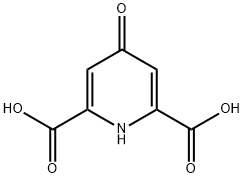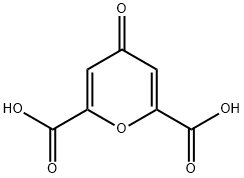
Chelidamic acid synthesis
- Product Name:Chelidamic acid
- CAS Number:138-60-3
- Molecular formula:C7H5NO5
- Molecular Weight:183.12

99-32-1

138-60-3
4-Oxo-1,4-dihydro-2,6-pyridinedicarboxylic acid was synthesized from betulinic acid using a modified literature method. The specific operation was as follows: 425 mL of 30% ammonia solution (containing NH3 41.8 g, 0.21 mol) was slowly added dropwise to the reaction system at 0 °C, and the dropwise addition process was controlled to be completed within 1 hour. After the dropwise addition, the reaction mixture was stirred continuously at room temperature for 48 hours. Upon completion of the reaction, the excess ammonia solution was removed by distillation under reduced pressure. Subsequently, the residue was mixed with 50 mL of water, activated carbon was added and decolorized by refluxing for 15 minutes. After hot filtration, the filtrate was collected and, after being cooled to room temperature, the pH was adjusted with a 37% aqueous hydrochloric acid solution to 1. At this point, a white solid precipitated from the solution, which was collected by filtration, washed several times with cold water, and finally dried under vacuum for 16 h. The target compound, 4-oxo-1,4-dihydro-2,6-pyridinedicarboxylic acid (13), was obtained as a white solid in a yield of 42 g with 98% yield.

99-32-1
204 suppliers
$9.00/250mg

138-60-3
261 suppliers
$6.00/5g
Yield:138-60-3 98%
Reaction Conditions:
with ammonia in water at 20; for 48 h;
Steps:
13 4.1.2.12. Chelidamic acid (1,4-dihidro-4-oxo-2,6-pyridinedicarboxylic acid) (13)
Chelidamic acid was synthesized using an adapted literature protocol.33 In a typical experiment, 425 mL of NH3 (30% aqueous solution) was added dropwise at 0°C to 12 (41.8 g, 0.21 mol) over a period of 1 h. After the addition was complete, the resulting suspension was stirred at room temperature for 48 h. The excess of aqueous ammonia solution was removed under reduced pressure and the residue was refluxed for 15 min with 50 mL of water using charcoal. After filtration, the hot filtrate was collected and after return to room temperature acidified with HCl (37% aqueous solution) until pH=1. The resulting white solid was filtered off, washed several times with cold water and dried under vacuum for 16 h. The desired compound 13 was obtained as a white solid (42 g, 98%).
References:
Gracia, Stéphanie;Arrachart, Guilhem;Marie, Cécile;Chapron, Simon;Miguirditchian, Manuel;Pellet-Rostaing, Stéphane [Tetrahedron,2015,vol. 71,# 33,p. 5321 - 5336]